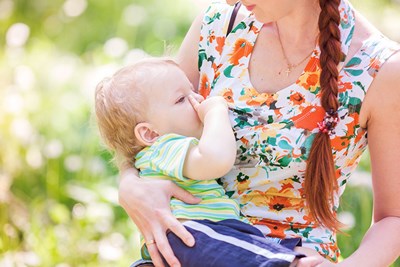Along with the many other changes happening in your pregnant body, by about the 31st week, you may begin to notice little wet spots in your bra. As your body prepares for your baby’s arrival, all the glands in your breasts start producing a thin, clear fluid that will eventually become breastmilk. Known as colostrum, it contains a variety of antibodies designed to help your baby start building up their immune system after birth. Until your baby is ready to make his grand appearance, however, there’s a few things you can do to keep your top dry.
Every woman experiences leaky breasts a little differently. Just because your mother’s breasts were leaking enough to start filling bottles before you even arrived doesn’t mean you will have the same experience -- you may not even leak at all. On average, the pale yellow or creamy colostrum starts toward the sixth month, but some mothers start lactating much earlier. If you are a first time mother, this can be a bit alarming, but it is nothing to be worried about. Additionally, if you don’t notice any colostrum, this doesn’t mean you aren’t going to lactate. While some women do have trouble producing breast milk, it’s difficult to tell until after the baby is born.
For women who do produce colostrum early on, your breasts are beginning to produce milk, and that’s great! You’ll continue making colostrum for the first few days of the baby’s life. Colostrum is designed especially for newborns, filled with the nutrients and antibodies they need. Eventually, your milk will change as your baby’s body develops and needs different nutrients, getting thicker or more protein-filled.
Nursing Pads
There’s nothing worse than looking down in the middle of a business meeting and seeing wet spots on your shirt. There’s a whole line of products designed for women with just this problem. Nursing pads are available in both reusable and disposable forms, and a box costs about $6. How long each lasts depends on how much colostrum you’re producing.
Reusable pads are a little thicker, and can be tossed in the washing machine when they are too full. Additionally, some nursing bras have little slots to slide pads into so they don’t move around too much. Many nursing bras have thicker linings to help catch extra leakage, and some maternity shirts are even designed to hide the issue a little better than others.
Releasing Colostrum
If you’re really having a problem, you can use your fingers to gently “milk” your nipples, releasing a little bit of the fluid so that it isn’t so built up. Massage your breasts gently, then place your thumb and index finger on the top and bottom of your areola. Move your breasts gently in towards your chest, squeeze slightly, and pull back out to drain the fluid. This is great in a pinch -- but so are a few layers of tissue if you don’t have anything else.
Unfortunately, this isn’t a problem that will go away if you intend to breastfeed. For the most part, your breasts should catch on to when your baby is ready to eat and start making more milk at those particular times of the day. However, it’s a good idea to keep a few nursing pads handy until your lactic glands completely dry up.


